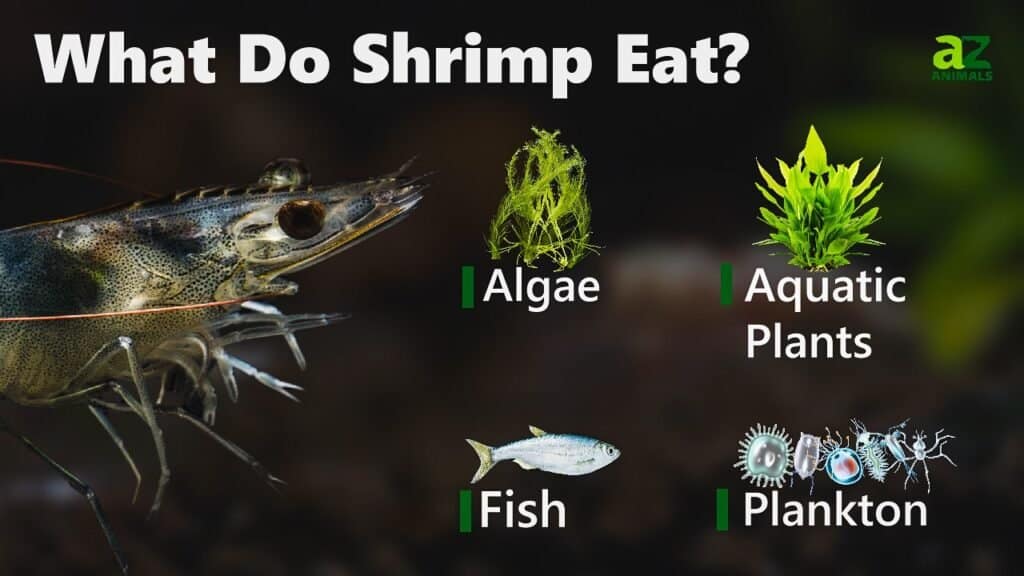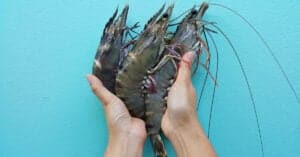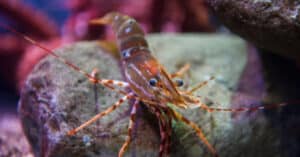The crustacean known as the shrimp is closely related to lobsters and crabs, but it has plenty of variety within its more immediate family line. There are roughly 600 shrimp species and 2,000 subspecies documented in the wild, and they can be found in every ocean and sea as well as in many freshwater sources. They’re also sometimes referred to as the “cockroaches of the sea”. It’s a sobriquet they’ve earned thanks for their reputation for eating anything within reach. But what do shrimp eat? While there are plenty of omnivores throughout the animal kingdom, few stretch the definition of the world as thoroughly as the shrimp.
In more accurate terms, they’re what’s known as “opportunistic omnivores”. If it will fit inside the mouth of a shrimp, the shrimp is probably going to devour it. As a result, the shrimp’s diet consists of everything from plant matter to worms to other shrimp. These animals don’t discriminate between living and dead matter either. They’re just as likely to feast on the rotting corpse of a fish as they are to make a meal of plankton. As a result, the diet of shrimps is wholly dependent on their environment — and the fact that they typically occupy the sea, lake, or river floor means that their diets consist of what all the other animals have left behind. What do shrimp eat the majority of the time? In most environments, a bulk of a shrimp’s diet will be comprised of plankton.
This can take two forms. Phytoplankton is microscopic plants and can take the form of diatoms, microalgae, or cyanobacteria. Phytoplankton comes in both photosynthetic and chemosynthetic forms. The latter is the prevalent food choice for shrimp since they don’t require light to survive. Zooplankton is similarly microscopic animals that can be found subsisting near the bottom of a body of water, and they’re present in both ocean and freshwater sources. Roughly a quarter of shrimp species occupy freshwater environments.

What Do Shrimp Eat in a Tank vs in the Wild?
Brine shrimp, ghost shrimp, and cherry shrimp are some of the most popular types of shrimp to put in a tank. The sea or lake floor may be a veritable buffet of delicacies for shrimp species, but most aquarium owners don’t want to line the floor of their habitat with decaying fish. But how much attention you need to pay to the shrimp in your tank will really depend on the surrounding environment. Ghost shrimp or cherry shrimp that are in colonies or share an aquarium with existing fish can often survive on microfilm and leftover food, but less populated tanks can require a more specialized diet. Algae wafers and shrimp pellets are the most popular choices for aquarium owners, but cherry shrimp, ghost shrimp, and brine shrimp are all known to enjoy blanched vegetables as well.
The type of food shrimp eats includes:
- Bacteria
- Chemosynthetic phytoplankton (algae, cyanobacteria, diatoms)
- Zooplankton
- Small fish and invertebrates
- Dead and decaying animal matter (clams, fish, snails, crabs)
How Do Shrimp Forage For Food?
The actual methods that shrimp use to forage for food can vary from species to species. Brine shrimp are filter feeders, which means that they strain potential food matter from water while swimming through it. Most shrimp species are mostly blind, and they instead rely on an awareness of their surroundings that bridge the gap between smell and taste. This chemosensory input allows them to sense chemicals from potential food in the wild. They similarly use their legs and tentacles to feel along the sandy floor and uproot potential prey burrowed underneath it.
Other shrimp employ more creative approaches to gathering food. Coral reefs are habitats that are abundant in marine animal life, and cleaner shrimp have found a unique niche in the coral reef ecosystem by cleaning bacteria and detritus off of the bodies of larger fish. It’s a symbiotic relationship, and these ocean shrimp will often set up cleaning stations throughout the coral reef where fish can congregate. Three to five shrimp will typically work together cleaning larger fish like parrotfish, snappers, and blue tang. It’s a symbiotic relationship where the shrimp meets its nutritional requirements and the fish is cleaned of potentially harmful bacteria and dead skin.
Even when they aren’t actively giving baths to local fish, shrimps always fulfill an important role within their habitats. As scavengers like vultures and hyenas, they remove dead organic matter and detritus from building up in their environment. In addition to removing the corpses of fish and other marine animals, these shrimp keep algae and plankton populations at manageable levels. Their ubiquity throughout the world’s oceanic and freshwater habits is a reflection of the valuable role they can play in practically any marine ecosystem.

©SritanaN/Shutterstock.com
What Animals Eat Shrimp?
Shrimp will eat practically anything that’s smaller than them, but their predators tend to be just as voracious. Shrimp are often used as fishing bait thanks to the fact that they’re appealing to both freshwater and saltwater fish. Cod, herring, and catfish have all been seen consuming shrimp, and they’re also preyed upon by larger marine mammals like whales and dolphins. Shrimp spend most of their lives at the lowest depths of their habitats, but there are other predators in their deepwater environments. Carpet sharks and stingrays both cling to the floor in search of prey that includes shrimp. Halibut and flounder also rank among the categories of bottom feeders that call shrimp a part of their diet.
But the biggest single predator of shrimp may be humans. We fish 7.4 billion pounds of shrimp per year, and one billion pounds of that end up in the stomachs of Americans. Unlike the native predators of shrimp, humans tend to actively farm these crustaceans. Shrimp farms can destroy important mangrove habitats and lead to unhealthy levels of antibiotics in the meat. Even more traditional shrimp fishing can be dangerous for the environment, as many fish and other marine creatures are accidentally killed and abandoned during the fishing process.
Up Next:
The photo featured at the top of this post is © iStock.com/Mariusz-W
Thank you for reading! Have some feedback for us? Contact the AZ Animals editorial team.






